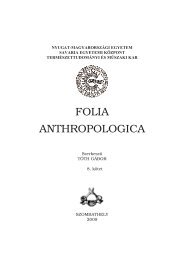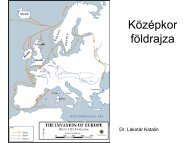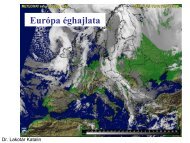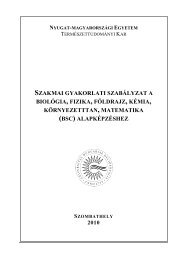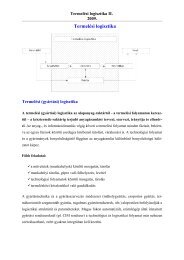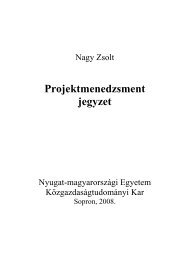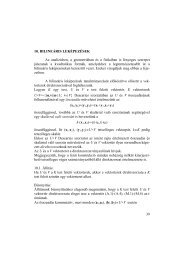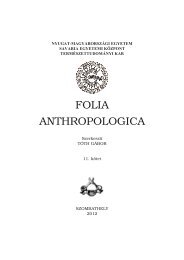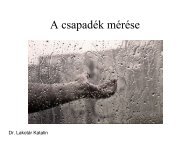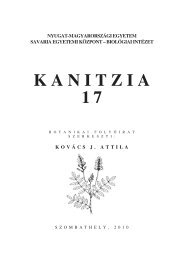You also want an ePaper? Increase the reach of your titles
YUMPU automatically turns print PDFs into web optimized ePapers that Google loves.
ember táplálkozási szokásairól számol be. Meg kell említenünk, hogy magyarországi minták vizsgálati<br />
eredményeiről is olvashatunk, melyek a dunántúli római korból, illetve az alföldi szarmata időszakból<br />
származnak (a dunántúli római kort a táci- (Gorsium) és a pécsi- (Sopiane), a szarmata kort a<br />
Madaras-Halmok reprezentálja.<br />
A könyv közel húsz év tudományos munkásságát, klinikai tapasztalatait közérthető módon foglalja<br />
össze, így melegen ajánljuk a témában elmélyedni kívánó tudományos szakemberek, egyetemi hallgatók<br />
valamint a régészet és történeti antropológia iránt érdeklődők számára.<br />
Végezetül, akinek a speciális szakterület felkeltette az érdeklődését, a bőséges irodalomjegyzék<br />
kellő mennyiségű közleménnyel szolgál a további kutatásokhoz.<br />
A könyv fejezetei:<br />
Introduction<br />
Human bone health in relation to the elemental composition of the soil in various geographic regions<br />
Attainability of elements from food<br />
Deposition of elements into bone tissue<br />
Basic building elements of bone<br />
Trace elements in ontogeny and physiology of bone tissue<br />
Trace elements and the European skeleton through 7000 years<br />
Reconstruction of dietary trends based on chemical analysis of elements<br />
Some human dietary patterns in Europe<br />
Conclusion<br />
(Márk László, PTE ÁOK Biokémiai és Orvosi Kémiai Intézet, Pécs, és Dr. Marcsik Antónia, SzTE TTK<br />
Embertani Tanszék, Szeged)<br />
Tóth, Gábor A.: Auxology. To the memory of Professor Ottó G. Eiben. Savaria University Press,<br />
Szombathely. 2005. 129 oldal.<br />
In a tender foreword Professor Cholnoky memorizes his colleague as a friendly, capable scientist<br />
with a pionering role in auxology in Hungary and an excellent international fame.<br />
Over forty authors discuss in 17 contributions several epidemiological aspects of auxology, as<br />
this science is related to a. o. lifestyle, socio-economic situation, nutrition, health care, education,<br />
hygiene and politics. Moreover, also clinical aspects of growth and maturation, and sporting may be<br />
approached by auxological methods.<br />
As expected, positive secular changes of height are reported in the European countries Slovenia,<br />
Croatia and Hungary. But a meanwhile welknown negative secular change, the critical increase of<br />
weight for height in developed countries, is also described for Hungary and Croatia and for immigrant<br />
children in Vienna. The shift to a lower age of the menarche is found to slow down gradually in a<br />
South-Western district of Hungary.<br />
Compared to the situation in North-Western Europe, in the United States a striking arrearage of<br />
the proces of increasing height takes place, in particular in the second half of the twentieth century. In<br />
a very critical comment the close relationship is pointed out with the poverty-stricken situaton of<br />
nearly 20 percent of the children, a high child mortality, and so many families without health<br />
insurance and preventive health care. As is seen elswhere, low social status goes together with overweight<br />
and obesitas, in the U.S. in an extreme way. Seen from the viewpoint of European countries the<br />
solution of these problems in the U.S., on average one of the wealthiest communities, must be much<br />
easier than in the situation described in Western Himalayas and Punjab. In the poor and remote<br />
villages there is undernutrition, either caloric or deficiency of a diversity of nutrients, or both. Besides<br />
the immediate need for healthy food, in the long run education and specific enlightenment, particularly<br />
of mothers, is necessary. It is not the drift to suggest what is possible in future, but the reported mean<br />
height in these territories is equal to the height of Dutch contemporaries one and a half century ago.<br />
In a Mexican project the somatic profiles are measured of two groups of children, one with a<br />
temporary faulty growth due to malnutrition at an earlier age. It is found that, although body height is<br />
114




